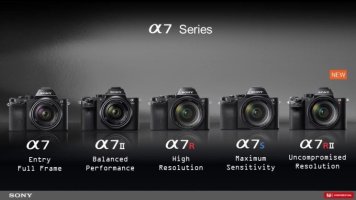benperrin said:
jrista said:
Now, there is more to the A7s than big pixels. It's been demonstrated that the A7s uses some kind of technology similar to Aptina's DRPix technology. DR Pix is dynamic range enhancement technology, operating along similar lines as MagicLantern's dual exposure (only better, more efficiently, and in the hardware). It doesn't kick in until after ISO 1600, however once it does kick in, it enhances dynamic range at higher ISO, which is why the A7s performs like a friggin powerhouse at ISO 400k. If the A7r II does not use this DR Pix like technology, then it is doubtful it would perform as well at high ISO. That said, we would once again be comparing apples and oranges...because there would be technology differences, rather than the same technology.
Hi Jon,
Have you decided to go with a Sony camera for your next camera or are you getting something else? I would love to hear your thoughts from an astro photography perspective. I haven't seen any high ISO examples from the a7rII which I would need to see before purchasing one. My 5dsr is still on pre-order with no release date given so I might consider the a7rII but at this stage the 5dsr is slightly ahead on paper for my needs.
Cheers,
Ben
I am definitely getting at least one Sony camera. I would already have the A6000, however the rumors keep cropping up about the A6100 or A7000, and the specs for the AF on the newer model sounds amazing, so I've been holding out. If the A6100/7000 is pushed out too much longer, I'll probably just get a used A6000.
I am also pretty certain that an A7r II is going to be my landscape camera. I am not sure that I would spend $3200 on it...not because I don't think it's worth it, but because I simply have too many things I need to buy, and my money can only go so far.

I am hoping it will drop to $2800 or around there soon enough, and I'll probably pick one up.
There are a number of reasons I'm so interested in Sony. I met a guy, Mike Malik, on an astro forum. He does DSLR and mirrorless astro modifications, so he's inside cameras from several brands all the time. He started modding Canon DSLRs, and was fairly impressed with the 6D. However, once he got his hands on a Sony (A7s I believe it was), he said on several occasions how blown away he was by the quality of them. The design, the internal layout and construction...he stated it was quite superior to how Canon builds their DSLRs. Not all the materials were ideal in some of the external cases, like the mount, but internally, apparently Sony cameras are EXTREMELY well built.
On top of that, once A7s vs. 6D comparisons started to show up, the differences were STARK. The A7s trounces the 6D, hands down, no contest, game over. With 50% more, even double, the integration time in 6D images, compared to short exposures at quite high ISO on the A7s , the A7s produces far cleaner results, with deeper exposure, than the 6D can deliver. Results at ISO 2000 and 3200 from the A7s look at least as good as ISO 100 in your average daytime photography. It's just mind boggling how good the A7s is for astro.
Now, the A7 and A7 II...they don't seem to be delivering quite the same IQ. They are good, but only marginally better than the 6D. We think the primary difference is that the A7s uses that dynamic range enhancement technology at high ISO (something similar to Aptina's DRPix technology), whereas the A7/A7 II do not. The A7r also seems to do quite well, and it certainly delivers the resolution, but even on a normalized basis, it's still not quite as good as the A7s for astro. At the moment, I think the A7s is hands down the best ILC on the market for astro, especially when astro modded. Cleanest, deepest results you can get without going to full CCD (and even then, CCD cameras require more integration time to produce similarly clean results....the CCD advantages are thermal regulation and cooling, and being mono most of the time, so they support LRGB and narrow band filtration.)
For the record, I have not seen Sony's lossy compression exhibit as a problem for astro very often. In very rare cases, you might find some compression artifacts around stars, but for the most part, the data once integrated appears very clean.
If you are interested in a Sony camera for astro, I would skip the A7/A7 II. Those will deliver marginally better quality than the 6D...and the 6D tends to be a much better buy. The A7s is really where it's at for astro on the Sony side. Phenomenal quality. We just recently had a discussion about using drizzle integration to increase the resolution of A7s images. The big pixels are great for high resolution imaging (bigger, longer scopes), but undersample with shorter scopes. Shorter scopes are much easier to image with, though. With drizzling, you can gain 50% or more resolution if you get enough subs, and process correctly. So you can get both the really clean results, as well as good resolution, by pairing the A7s with drizzle integration.



